Bee corridor to prevent bee robbery (SKU: CK05D)
Innovative product presented at the Api Slovenija fair
We introduce to you the bee corridor for preventing bee robberies, a unique beekeeping product. Its design has been inspired by the genuine desire for a product which would help beekeepers around the world to preserve their business and the joy of beekeeping.
Its development was based on an effective concept for preventing bee robberies, which we improved to produce an innovative product which we are pleased to present below.
Use of the bee corridor is a tested and efficient method for preventing bee robberies
The principle of operation of the corridor is known to every beekeeper, since it is a proven method for preventing bee robberies. Beekeepers use various devices for this purpose. However, it is crucial to produce the effect of a corridor. With the bee corridor, which is inserted into the entrance of the beehive during the time of bee robbing danger, the power of the attacker bees is significantly reduced and the defence capability of the guard bees is increased.
Back in 2013, Vlado Augustin, an adviser with the Beekeeping Public Advisory Service (JSSČ), a specialist in the field of beekeeping technology, wrote in the Slovenski čebelar magazine (Number 7-8) about "the tunnel that prevents bee robberies". He added:
"The most effective way to prevent bee robberies is to use the so-called “tunnel', which can be inserted in the entrance."
A long-time president of the Belgrade Beekeepers' Association, Boza Petrovic recommends the use of the "tunnel" as a prevention of bee robbery, whereby the operation is described as:
"The principle of operation is based on the way bees move as they enter the hive of another bee colony to loot the honey. A foreign bee would try to get to the honey as soon as possible and that is why it immediately moves upwards against the inner side of the front beehive wall. Resident bees move differently. They enter the hive through the entrance and move through the centre of bottom board, and exit the hive by moving parallel to the hive's entrance. It seems that an invisible traffic signalman is controlling the movement of bees both inside and outside the hive. When a foreign bee gets into the tunnel, it can't go up. It flies in circles disoriented, until the guard bees drive it out."
Our bee corridor is an upgrade of the already known corridor effect
The bee corridor for preventing a bee robbery is an upgrade of the already known corridor or tunnel effect. We took a verified concept, upgraded it with a double tube corridor, which enables half-closing of the corridor, and made it from a durable ABS plastic material which is resistant to UV light and without any negative effect on bees.
By using the bee corridor anyone is able to protect their bees from bee robberies in the most efficient and tested way!
- The corridor is suitable for Anton Žnideršič beehive and other beehive systems with an entrance of at least 50 x 8mm.
- The corridor is made of high-quality ABS plastic with a very long service life.
When is the bee corridor used?
The bee corridor is inserted in the beehive entrance at the end of honey flow. This is in July, after the last honey extraction when the bee feeding starts. The corridor is kept in the beehive until winter, when it is removed from the beehive to provide better ventilation and facilitate the bees to remove dead worker bees from the beehive.
Comparison of the method of narrowing the beehive entrance and the use of the bee corridor
Many beekeepers are trying to protect their bee colonies from bee robberies by narrowing the beehive entrance during the danger of bee robbery. This method somewhat reduces the intensity of the attack, but in most cases it does not prevent the bee robbery because attacker bees that penetrate the defensive line of the resident bees immediately spread throughout the hive. Because the attack is spread, defender bees cannot protect their colony.
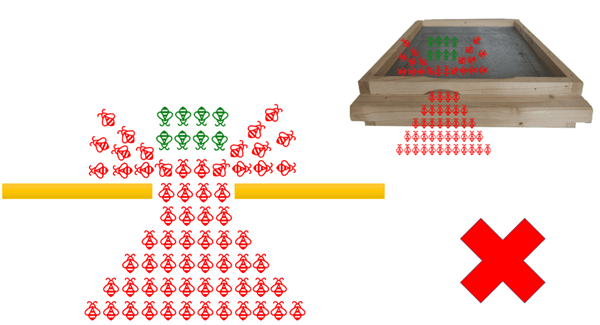
Narrowing a beehive entrance is not an effective defence against bee robberies
- The attacker bees enter the narrowed beehive entrance and get past the defender bees.
- As soon as the attacker bees invade the hive, they spread through its entire interior and fly to the honeycomb.
- Because the attack is spread, the resident bees cannot protect their hive and colony.

Using the bee corridor is an effective defence against bee robberies
- In the event of an attempted robbery, the attacker bees are forced to take the long corridor and they become confused and disoriented which enables the defender bees in the corridor or at its the exit to attack and drive them out.
- The intensity of the attack of a large number of attacker bees is neutralised since they must follow the corridor in a line, one by one.
Is the bee corridor for preventing bee robberies comparable to the conical bee escape board?
The bee corridor and conical bee escape board (see the image) are completely different items of beekeeping equipment. While the bee corridor is intended for preventive defence against bee robberies, the conical bee escape board can only be used when the bee robbery is already in progress.
The conical bee escape board narrows the beehive entrance and cannot be used as a prevention measure for a longer period when there is a danger of bee robbery (in summer and autumn) since it significantly hinders the entry/exit not only to potential attacker bees, but also to the resident bee colony.
The bee corridor, on the other hand, completely prevents the robbery through its preventive design. It is inserted into the beehive at the time of the danger of bee robbery (in July, at the end of the honey flow period) and left there until winter. The corridor maintains a width of 5cm throughout its length, so it does not hinder the resident bee colony in its daily routine.
Half-closing the corridor in case of a weak bee colony
In the case of a weak bee colony, the corridor can be half closed using the provided closure plate (only one tube of the corridor is closed). Thus the weak bee colony (e.g. nucleus colony) is additionally protected against a potential bee robbery, since the method of narrowing beehive entrance is used in addition to the bee corridor principle.
Using a closure plate with vent holes, the corridor and the beehive entrance can be completely closed, if necessary.
Bee corridor for preventing a bee robbery
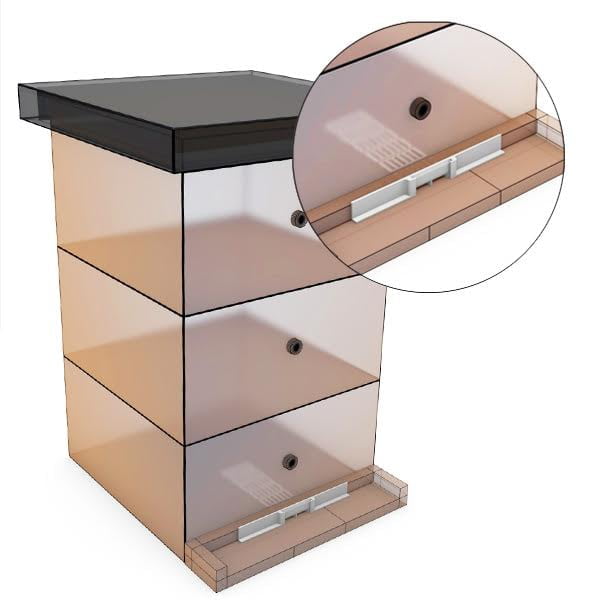
Universality
The corridor is suitable for all hive systems with an entrance of at least 50 × 8mm.
Durability
The corridor is made of high-quality ABS plastic with a very long service life.
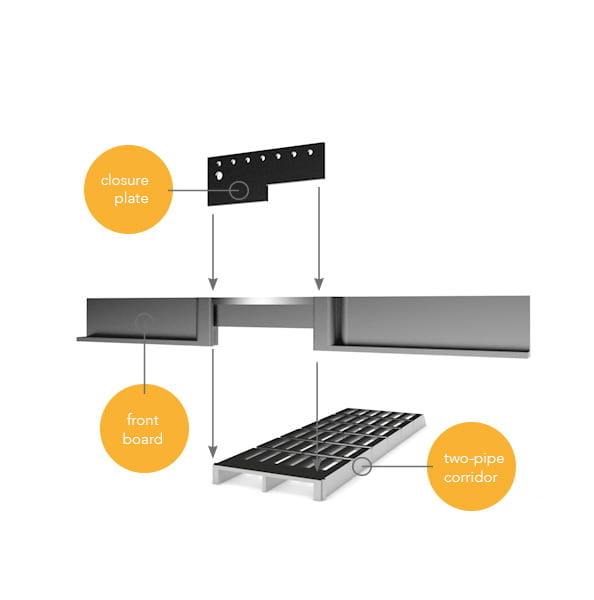
The corridor is connected to the front board and inserted into the entrance of the hive. Before inserting it, it must be checked if there are any obstacles in the hive to prevent insertion. Any obstacles are removed or the corridor is shortened at the designated places. With the closure plate, the entrance to the corridor is partially or completely closed. It is put in the front board.
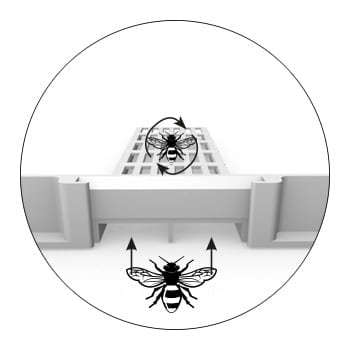
1. Basic effectiveness
The corridor cuts off the attacker bees’ direct way to the honeycomb and disorientates them so that they fly in circles. This way the guard bees can easily drive them away.
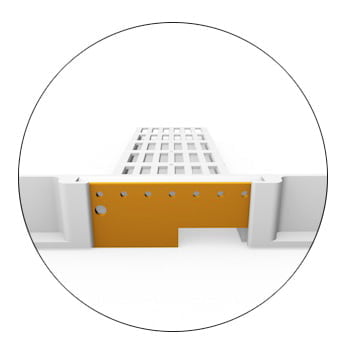
2. Increased effectiveness
The effectiveness is additionally increased when the corridor is half closed with the closure plate.
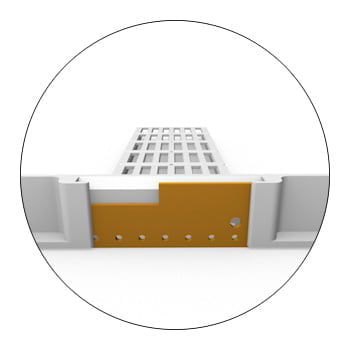
3. Additional uses
With the closure plate, the entrance to the hive can be completely closed if necessary.
Bee Corridor reviews (german)
Image Gallery

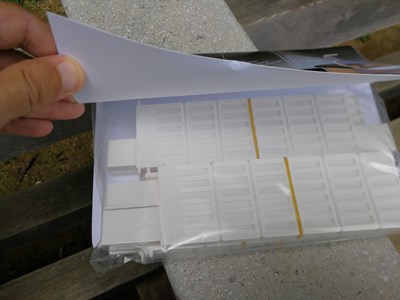
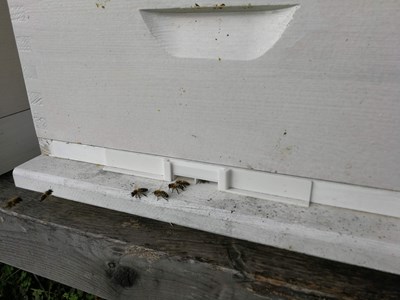
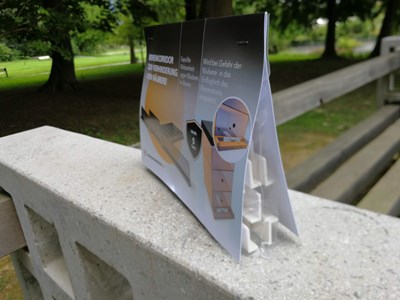

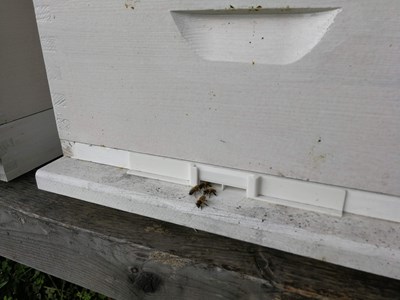
Request a quote
Do you need further information or a personally prepared offer? Send us a question and we will answer you as soon as possible.
